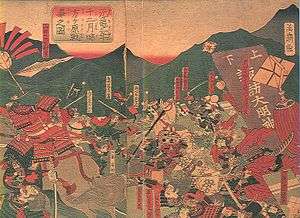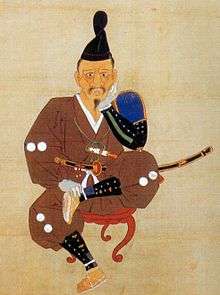Battle of Mikatagahara
| Battle of Mikatagahara | |||||||
|---|---|---|---|---|---|---|---|
| Part of the Sengoku period | |||||||
 Battle of Mikatagahara | |||||||
| |||||||
| Belligerents | |||||||
| forces of Takeda Shingen | forces of Tokugawa Ieyasu and Oda Nobunaga | ||||||
| Commanders and leaders | |||||||
| Strength | |||||||
| 35,000 |
11,000 Total (8,000 Tokugawa troops, plus 3,000 from Oda Nobunaga) | ||||||
| Casualties and losses | |||||||
| Accounts vary from 100 to 500. | Accounts vary from 500 to 2000 | ||||||
The Battle of Mikatagahara (三方ヶ原の戦い Mikatagahara no tatakai) (January 25, 1573; Tōtōmi Province, Japan) was one of the most famous battles of Takeda Shingen's campaigns, and one of the best demonstrations of his cavalry-based tactics. It was also one of Tokugawa Ieyasu's worst defeats, and complete disaster was only narrowly averted.
According to the Japanese calendar, the battle was fought on the 22nd day, 12th month, the year Genki-3.
Background
In October 1572, after having concluded alliances with his rivals to the east (the Late Hōjō clan of Odawara and the Satomi clan of Awa), and after waiting for the snow to close off the northern mountain passes against his northern rival, Uesugi Kenshin, Takeda Shingen led an army of 30,000 men south from his capital of Kōfu into Tōtōmi Province, while Yamagata Masakage led a second force of 5,000 men into eastern Mikawa Province. They quickly captured Yoshida Castle and Futamata Castle.[1]
Shingen was opposed by Tokugawa Ieyasu, based at Hamamatsu Castle with 8,000 men, plus an additional 3,000 reinforcements received from his ally, Oda Nobunaga. However, Takeda's intent was not to attack Ieyasu nor to seize Hamamatsu; rather, he wished to avoid conflict if possible to save his forces to destroy Nobunaga and to march on Kyoto.[2]
First attack
Against the advice provided by Sakuma Nobumori, Hiraide Norihide and Takigawa Kazumasu, who had been sent by Nobunaga, and by his own generals, Ogasawara Nagayoshi, Matsudaira Ietada, Honda Tadakatsu, Sakai Tadatsugu, and Ishikawa Kazumasa, Ieyasu refused to allow the Takeda to pass through his territory unhindered, and drew up his forces on a high plain called Mikatagahara, just north of Hamamatsu.[1][3]
According to the Kōyō Gunkan, the contemporary Takeda military history, Shingen outnumbered Ieyasu three-to-one, and organized his men in the gyorin (魚鱗, fish-scale) formation, enticing his opponent to attack. Ieyasu's troops were arranged in a line.[3] Oyamada Nobushige was in Shingen's vanguard, followed by Naitō Masatoyo and Yamagata Masakage. The third line was commanded by Katsuyori and Obata Masamori, while Baba Nobuharu was in the fourth.[1]
At around four in the afternoon, snow began to fall, and the arquebusiers opened fire, along with a number of peasant stone-throwers. Firearms, being new to Japanese warfare, were an unbalancing factor and Ieyasu may have expected his superior weaponry to defeat Shingen's tactical attempts. Naitō Masatoyo attacked Honda Tadakatsu. However, Shingen then let loose his famous cavalry charge; his horsemen raced towards the gunners, and overran them. The Tokugawa forces stood firm on the left flank despite many casualties, the allies provided by Nobunaga were overwhelmed, with Hiraide Norihide killed, and Takigawa and Sakuma fleeing the battle.[4]
Second attack
Shingen then withdrew his forward troops, offering them an opportunity to rest, and brought forward a new set of horsemen initiated a new charge, led by Takeda Katsuyori and Obata Masamori, with Saegusa Moritomo leading a 50-man cavalry charge. They were soon joined by the main body of the Takeda army, which drove the Tokugawa into full retreat. Ieyasu sent one of his commanders, Ōkubo Tadayo, to plant his giant golden fan standard (uma-jirushi) to serve as a rallying point at Saigadake, where the high plains began to drop off. He then sought to re-engage the Takeda army, to free his trapped general Mizuno Tadashige, but was persuaded by Natsume Yoshinobu to retreat; as head of the Tokugawa clan, Ieyasu's life was too important. Yoshinobu then led a charge into the Takeda line, and was killed. Other notable samurai sacrifices were made by Naruse Masayoshi, Toyama Kosaku, and Endo Ukon.[3]

Retreat
When Tokugawa returned to Hamamatsu Castle, he was accompanied by only five men. The town was on verge of panic as rumor had already reached Hamamatsu that the battle had gone badly.[5] Nevertheless, Ieyasu commanded that the castle gates remain open, and that braziers be lit to guide his retreating army back to safety. Sakai Tadatsugu beat a large war drum, seeking to add encouragement to the returning men of a noble, courageous retreat. When the Takeda vanguard, led by Baba Nobuharu and Yamagata Masakage heard the drums, and saw the braziers and open gates, they assumed that Tokugawa was planning a trap, and so they stopped and made camp for the night.[3]
In the night, a small band of Tokugawa ninja led by Hattori Hanzō, Ōkubo Tadayo, and Amano Yasukage attacked the Takeda camp,[2] throwing the vanguard of the Takeda army into confusion. Uncertain of the remaining strength of the Tokugawa forces, and worried that reinforcements from Oda Nobunaga and/or Uesugi Kenshin were on their way, Takeda Shingen decided to withdraw his forces back to his own territories and to try again the following year. However, for Shingen, there would be no following attack on Hamamatsu, as he would be fatally wounded in January 1573 at the Siege of Noda Castle.[6]
Notes
References
- Sadler, A. L. The Maker of Modern Japan: The Life of Shogun Tokugawa Ieyasu. Olympia Press (2009) ISBN 1-60872-111-6
Coordinates: 34°42′36″N 137°43′09″E / 34.71000°N 137.71917°E